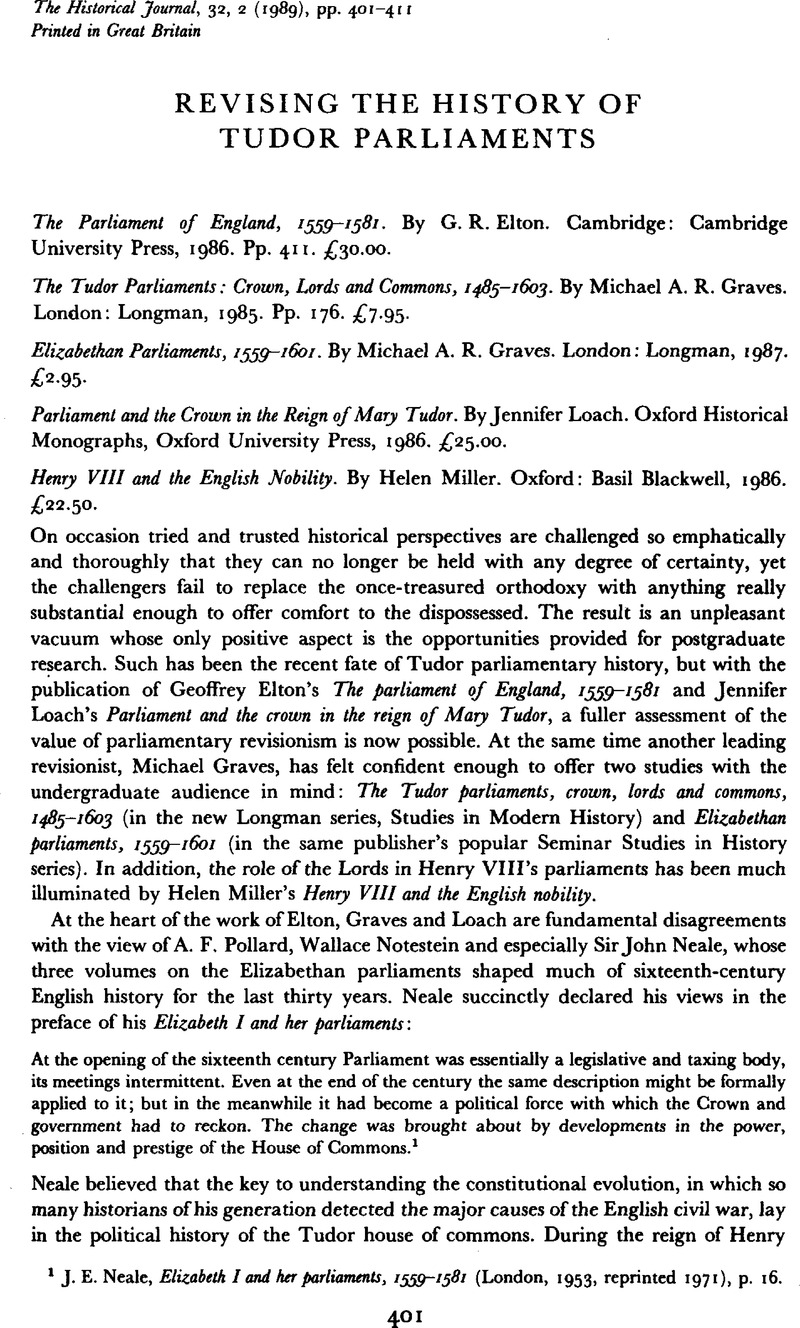Published online by Cambridge University Press: 11 February 2009

1 Neale, J. E., Elizabeth I and her parliaments, 1559–1581 (London, 1953Google Scholar, reprinted 1971), p. 16.
2 Ibid. p. 28.
3 Cited in Graves, , The Tudor parliaments, pp. 10–11Google Scholar.
4 G. R. Elton, ‘“The Body of the whole realm”: parliament and representation in medieval and Tudor England’, ‘Parliament in the sixteenth century: functions and fortunes’ and ‘Tudor government: the points of contact. I. Parliament’ all reprinted in his Studies in Tudor and Stuart politics and government, Volumes II and III (Cambridge, 1974, 1983).
5 See his articles in Studies, Vol. III.
6 Thus, for example, Elton's, ‘Piscatorial politics in the early parliaments of Elizabeth I’ in McKendrick, Neil and Outhwaite, R. B. (eds.), Business life and public policy: Essays in honour of D. C. Coleman (Cambridge, 1986), pp. 1–20Google Scholar and Dean, D. M., ‘Public or private? London, leather and legislation in Elizabethan England’, Historical Journal, XXXI (1988), 525–48CrossRefGoogle Scholar. Recent theses include Ericson, Carl, ‘Parliament as a legislative institution in the reigns of Edward VI and Mary’ (Univ. of London Ph.D. thesis, 1973)Google Scholar and Dean, D. M., ‘Bills and Acts, 1584–1601’ (Univ. of Cambridge Ph.D. thesis, 1984)Google Scholar.
7 The only published account is Neale, J. E., Elizabeth I and her parliaments, 1584–1601 (London, 1957Google Scholar, reprinted 1971), pp. 84–8.
8 Graves, M. A. R., ‘Thomas Norton the parliament man: an Elizabethan M.P., 1559–1581’, Historical Journal, XXIII (1980), 17–35CrossRefGoogle Scholar and ‘The management of the Elizabethan house of commons: the council's “men-of-business”’, Parliamentary History, II (1983), 11–38Google Scholar.
9 See, for example, Sharpe, Kevin (ed.), Faction and parliament (Oxford, 1978)Google Scholar.
10 This last identification has been made by Norman Jones in a forthcoming article.
11 Much more will be revealed by Terry Hartley's edition of the diaries and separatesfor 1584–1601.
12 Jones, Norman, Faith by statute (London, 1982)Google Scholar.
13 Graves, M. A. R., The house of lords in the parliaments of Edward VI and Mary I (Cambridge, 1981)CrossRefGoogle Scholar.
14 Neale, J. E., The Elizabethan house of commons (London, 1949), pp. 15–16Google Scholar.
15 Miller, H., ‘Lords and commons, relations between the two houses of parliament, 1509–1558’, Parliamentary History, 1 (1982)Google Scholar.
16 Russell, C. S. R., ‘The nature of a parliament in early Stuart England’, in Tomlinson, H. (ed.), Before the English Civil War (Macmillan, 1983), pp. 124–5Google Scholar.
17 A good example is Pauline Croft, ‘Parliament, purveyance and the city of London 1589–1608’, Parliamentary History, IV (1985)Google Scholar.
18 See, for example, Bowler, G., ‘“An axe or an act”: the parliament of 1572 and resistance theory in early Elizabethan England’, Canadian Journal of History, XIX (1984), 349–59CrossRefGoogle Scholar; Lake, Peter, Anglicans and Puritans (London, 1988)Google Scholar and Sommerville, J., Politics and ideology in England, 1603–1640 (London, 1986)Google Scholar. Some helpful perceptions have been offered by Collinson, Patrick in ‘The monarchical republic of Elizabeth I’, Bulletin of the John Rylands Library, LXIX (1987), 394–424CrossRefGoogle Scholar.